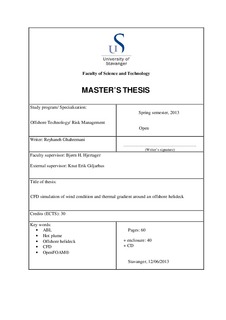| dc.description.abstract | With the development of offshore deep water fields, helicopter transportation and consequently helicopter deck becomes a vital part of these fields that located far from onshore. To ensure helicopter safe operations, aerodynamic hazards around an offshore platform and helideck need to be identified and risks of such disturbances should be minimized. The main sources of environmental hazards around an offshore platform are vertical air flow fluctuation (σz), and temperature increase above the helideck (Morrison, 2001). According to British CAP 437 standard, vertical air flow fluctuation should be less than 1.75 m/s above the helideck. Furthermore, temperature increase should be less than 2◦C according to NORSOK C-004 and CAP 437 standards. In order to examine such aerodynamic disturbances, Atmospheric Boundary Layer (ABL) and hot air flow is simulated by OpenFOAM®2.1.1 as an open source Computational Fluid Dynamic (CFD) toolbox.
In this thesis, ABL simulation is first done for a simple geometry, and then it is developed for real offshore fixed platform geometry as wind environment disturbed in vicinity of offshore platform as a major obstacle, and turbulent eddies would be generated. Turbulence models applied for helideck simulations are k-ε and RSM turbulence model to assess which one going to present the real situation best. In addition, to examine thermal gradient, hot exhausted air flow is simulated for a simple geometry. To validate simulation results of this project as it is done by an open source code, the models are also simulated by KFX® CFD simulator in parallel by Dr. Giljarhus, and its results compared by simulation results of OpenFOAM.
In ABL simulations of simple geometry, results of horizontal velocity, turbulent kinetic energy, dissipation rate and turbulent eddy viscosity are plotted for different location at geometry length against height to assess how theses profile developed from inlet to outlet, and the OpenFOAM results compared with KFX results. In ABL simulation of real platform geometry, σz is calculated as it is one of the main missions of this report, and the results are plotted for coarse and fine mesh for k-ε and RSM turbulence models, and also turbulent kinetic energy pattern is shown and compared with KFX. For hot plume simulation, the location of 2◦C isotherm is identified and the plume pattern and sizing is compared with KFX.
ABL simulation results for a simple geometry show a great homogeneity with KFX results especially for velocity profile. Regarding hot plume simulation, the plume pattern and its sizing validated as it is fairly similar compare to KFX result. And finally, In ABL helideck simulations, it is found that vertical airflow fluctuation is acceptable for the defined wind condition, as it is less than 1.75 m/s criterion. Furthermore, comparison between simulation results of k-ε and RSM turbulence models show that k-ε turbulence model generate more turbulent kinetic energy and consequently more vertical air flow fluctuation compare to RSM model. | no_NO |
